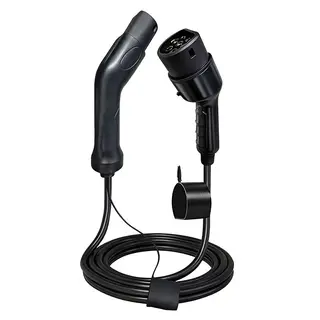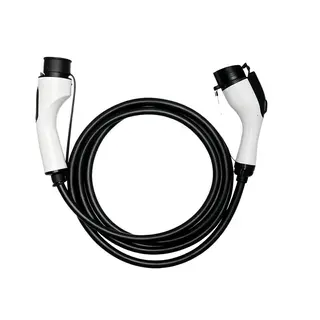With the popularization of electric vehicles, charging piles, as their important supporting facilities, are gradually becoming the focus of attention. Charging piles not only provide energy supply for electric vehicles but also, to a certain extent, influence the user experience and safety of electric vehicles. This article will deeply analyze the core components of electric vehicle chargers to help you better understand their working principles and key points for selection.
Charging piles are mainly divided into AC charging piles and DC charging piles. AC charging piles are usually called "slow chargers", while DC charging piles are referred to as "fast chargers".
AC charging piles are fixed devices installed outside electric vehicles and connected to the power grid. They provide AC power to the onboard charger of the electric vehicle. Since AC charging piles themselves do not have the charging function, they must be connected to the onboard charger to charge the electric vehicle. In contrast, DC charging piles can directly provide DC power to the power battery of the electric vehicle, resulting in faster charging speed, though the cost is relatively higher.
AC charging piles can be divided by the number of AC phases into single-phase AC and three-phase AC, and by charging power into specifications such as 2 kW, 3.3 kW, 7 kW, 11 kW, and 22 kW. Among these, the most commonly used is the household single-phase 220V 7 kW charging pile. The input voltage of DC charging piles adopts three-phase four-wire AC 380V ±15%, frequency 50 Hz, which after internal rectification outputs adjustable DC power. Common power levels include 30 kW, 60 kW, 90 kW, 120 kW, and others.
Understanding the main components of charging piles is the foundation of selecting and using them. Although there are many types, the core components are generally the same. These components work together to ensure that charging piles can charge electric vehicles safely and efficiently.
The pile body is the outer shell of the entire device, usually made of steel, aluminum alloy, and other materials, with strong durability and stability. It not only protects internal parts but also prevents external environmental damage. A solid and durable pile body can effectively extend service life and reduce maintenance costs.
The charging module is the core part of the charging pile, including the charger, controller, and power supply.
The charger is the main component, responsible for converting electrical energy into the form required by the electric vehicle.
The controller manages the operating state of the charger and various parameters during charging, ensuring safety and stability.
The power supply provides energy to the charging module.
In DC charging piles, the charging module also includes a rectifier to convert AC into DC to meet the needs of EV power batteries.
The display screen shows information such as pile status, charging progress, and charging cost. Screens vary in type and size, with some piles equipped with touchscreens for user interaction, allowing users to select charging modes and view charging time and cost. The clarity and ease of use of the screen directly affect user experience.
This module calculates the charging fee based on real-time electricity price and consumed power, then collects payment and prints receipts. It requires cooperation between the controller and an embedded printer. Charging piles usually adopt tiered pricing policies. The controller calculates the cost, and the printer, communicating with the controller, prints detailed bills. This ensures accuracy and transparency in billing.
The cables serve as the bridge between the pile and the EV, transmitting power and data. Cable quality and length directly influence charging efficiency and safety. Some high-end piles have automatic cable retractors for convenience. High-quality cables reduce energy loss, improve efficiency, and prevent safety hazards caused by cable damage.
These include leakage protection, overcurrent protection, and overvoltage protection. Leakage breakers automatically cut off power in the event of leakage or other faults. Overcurrent and overvoltage protection prevent damage to the EV under abnormal conditions. These devices are indispensable for ensuring safe and reliable charging.
After gaining an understanding of the main components of a charging station, we will now take a closer look at their specific functions and roles to help you better grasp the working principles and importance of charging stations.
The LED board alerts staff to the pile's current status. When faults such as overvoltage, undervoltage, overheating, overload, short circuit, low temperature, lightning strike, emergency stop, or leakage occur, the red fault light turns on. When successfully connected to a vehicle and charging begins, the green light turns on. Wiring includes control lines for red fault light (B), green operation light (G), yellow power indicator (Y), and a 12V common power line (V). These indicators allow users to quickly judge pile status and address issues.
The LCD enables human-machine interaction. It allows users to choose charging methods, view charging time, energy, and cost. The power interface includes CNA1 plug pin 2 (485B), CNA1 plug pin 3 (485A), LCD V for +12V, and LCD G for -12V. Through the LCD, users can easily monitor charging progress and cost, improving convenience.
The card reader identifies user information. It supports billing, timing, self-service swiping, balance inquiry, and billing inquiry through user authentication. Interfaces include +5V power (PW), ground (GND), transmit data (TXD), and receive data (RXD). With the reader, users can authenticate and pay conveniently for self-service charging.
Through remote access, users can monitor power, current, voltage, and switches in real time or at intervals. Operators can remotely control charging switches, adjust parameters, and address alarms. If faults occur, the system can dispatch repair personnel. This greatly improves management efficiency and maintenance timeliness.
The leakage breaker automatically cuts off power in the event of leakage or other issues. It is a low-voltage device that must be installed in power distribution systems. Types include universal breakers, molded-case breakers, and terminal breakers. Since charging piles operate in harsh environments, their breakers require higher performance than ordinary ones, for example, detecting smooth DC leakage signals and tripping accordingly. Traditional breakers rely on zero-sequence current transformers and induced voltages in secondary coils, processed by leakage detection chips (e.g., 54123 chip). When the leakage signal reaches the preset threshold, the chip triggers a warning or cuts power. However, in DC systems with smooth leakage currents, traditional breakers are unsuitable, requiring specialized DC leakage breakers.
The shunt reduces large currents to measurable levels for metering. Since DC charging piles carry very high currents and thick wires, directly connecting energy meters is difficult and unsafe. A shunt, a precise small resistor, placed in series in the current circuit allows measurement of voltage drop across it, which corresponds to actual current. The meter scale must match the shunt resistance. This ensures accurate current measurement and billing.
After understanding the main components of a charging station and their functions, let's look at the key points to consider when selecting one.
If you primarily charge at home or in a fixed location, an AC charging station is a good choice. It is easy to install, cost-effective, and suitable for long charging sessions. If you need fast charging or frequently use public charging points, a DC charging station is more appropriate. Although DC chargers are more expensive, they offer rapid charging speeds, meeting your urgent charging needs.
When choosing a charging station, it is essential to focus on the quality of its core components. High-quality charging modules ensure safe and stable charging while reducing the likelihood of malfunctions. The performance of the display screen and card reader also directly affects the user experience. Opting for products that are easy to operate and have clear displays can enhance charging convenience.
Safety protection features are indispensable for charging stations, as they effectively safeguard both the station and the electric vehicle. When selecting a charger, ensure it is equipped with comprehensive safety mechanisms such as leakage protection, overcurrent protection, and overvoltage protection. Choosing products that meet recognized safety standards is crucial.
As a long-term-use device, after-sales service is very important for charging stations. When purchasing, select manufacturers with reliable after-sales support to ensure timely maintenance and replacement if any issues arise, reducing potential concerns during use.
As an essential supporting facility for electric vehicles, the quality and performance of a charging station's core components directly impact the user experience and safety. Through this detailed introduction, you should now have a deeper understanding of these key components. When selecting a charging station, be sure to choose the type that fits your needs, focus on core component quality, prioritize safety protection features, and consider after-sales service. This guidance aims to help you select a safe, efficient, and convenient charging solution for your electric vehicle.



